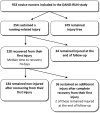A prospective study on time to recovery in 254 injured novice runners
- PMID: 24923269
- PMCID: PMC4055729
- DOI: 10.1371/journal.pone.0099877
A prospective study on time to recovery in 254 injured novice runners
Abstract
Objectives: Describe the diagnoses and the time to recovery of running-related injuries in novice runners.
Design: Prospective cohort study on injured runners.
Method: This paper is a secondary data analysis of a 933-person cohort study (DANO-RUN) aimed at characterizing risk factors for injury in novice runners. Among those sustaining running-related injuries, the types of injuries and time to recovery is described in the present paper. All injured runners were diagnosed after a thorough clinical examination and then followed prospectively during their recovery. If they recovered completely from injury, time to recovery of each injury was registered.
Results: A total of 254 runners were injured. The proportion of runners diagnosed with medial tibial stress syndrome was 15%, 10% for patellofemoral pain, 9% for medial meniscal injury, 7% for Achilles tendinopathy and 5% for plantar fasciitis. Among the 220 runners (87%) recovering from their injury, the median time to recovery was 71 days (minimum = 9 days, maximum = 617 days).
Conclusions: Medial tibial stress syndrome was the most common injury followed by patellofemoral pain, medial meniscal injury and Achilles tendinopathy. Half of the injured runners were unable to run 2×500 meters without pain after 10 weeks. Almost 5% of the injured runners received surgical treatment.
Conflict of interest statement
Figures
Similar articles
-
Diagnoses and time to recovery among injured recreational runners in the RUN CLEVER trial.PLoS One. 2018 Oct 12;13(10):e0204742. doi: 10.1371/journal.pone.0204742. eCollection 2018. PLoS One. 2018. PMID: 30312310 Free PMC article. Clinical Trial.
-
Prospective comparison of running injuries between shod and barefoot runners.Br J Sports Med. 2016 Apr;50(8):476-80. doi: 10.1136/bjsports-2014-094482. Epub 2015 Jun 30. Br J Sports Med. 2016. PMID: 26130697
-
A systematic review of running-related musculoskeletal injuries in runners.J Sport Health Sci. 2021 Sep;10(5):513-522. doi: 10.1016/j.jshs.2021.04.001. Epub 2021 Apr 20. J Sport Health Sci. 2021. PMID: 33862272 Free PMC article.
-
Running with injury: A study of UK novice and recreational runners and factors associated with running related injury.J Sci Med Sport. 2018 Dec;21(12):1221-1225. doi: 10.1016/j.jsams.2018.05.021. Epub 2018 May 24. J Sci Med Sport. 2018. PMID: 29853263
-
The Proportion of Lower Limb Running Injuries by Gender, Anatomical Location and Specific Pathology: A Systematic Review.J Sports Sci Med. 2019 Feb 11;18(1):21-31. eCollection 2019 Mar. J Sports Sci Med. 2019. PMID: 30787648 Free PMC article.
Cited by
-
Medial Tibial Stress Syndrome in Novice and Recreational Runners: A Systematic Review.Int J Environ Res Public Health. 2020 Oct 13;17(20):7457. doi: 10.3390/ijerph17207457. Int J Environ Res Public Health. 2020. PMID: 33066291 Free PMC article.
-
THE START-TO-RUN DISTANCE AND RUNNING-RELATED INJURY AMONG OBESE NOVICE RUNNERS: A RANDOMIZED TRIAL.Int J Sports Phys Ther. 2018 Dec;13(6):943-955. Int J Sports Phys Ther. 2018. PMID: 30534460 Free PMC article.
-
Influence of custom-made and prefabricated insoles before and after an intense run.PLoS One. 2017 Feb 28;12(2):e0173179. doi: 10.1371/journal.pone.0173179. eCollection 2017. PLoS One. 2017. PMID: 28245273 Free PMC article.
-
Elastography in the assessment of the Achilles tendon: a systematic review of measurement properties.J Foot Ankle Res. 2023 Apr 27;16(1):23. doi: 10.1186/s13047-023-00623-1. J Foot Ankle Res. 2023. PMID: 37101290 Free PMC article.
-
THE MANAGEMENT OF PROXIMAL HAMSTRING TENDINOPATHY IN A COMPETITIVE POWERLIFTER WITH HEAVY SLOW RESISTANCE TRAINING - A CASE REPORT.Int J Sports Phys Ther. 2020 Oct;15(5):814-822. doi: 10.26603/ijspt20200814. Int J Sports Phys Ther. 2020. PMID: 33110701 Free PMC article.
References
-
- Buist I, Bredeweg SW, van Mechelen W, Lemmink KA, Pepping GJ, et al. (2008) No effect of a graded training program on the number of running-related injuries in novice runners: A randomized controlled trial. Am J Sports Med 36: 33–39. - PubMed
-
- Nielsen RO, Ramskov D, Sørensen H, Lind M, Rasmussen S, et al. (2011) Protocol for the dano-run study: A 1-year observational follow up study on running related injuries in 1000 novice runners. Br J Sports Med 45: 365.
MeSH terms
LinkOut - more resources
Full Text Sources
Other Literature Sources
Medical


